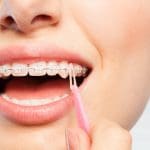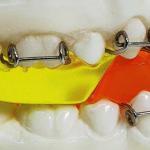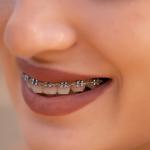Open bite is a dental condition that occurs when there is a space between the upper and lower teeth when the mouth is closed. This gap can affect a person’s speech, eating habits, and overall appearance. Open bite is a malocclusion, meaning it is an abnormal bite relationship between the upper and lower teeth. Malocclusion can be caused by genetic factors, habitual behaviors, or developmental abnormalities.
What is Open Bite?
An open bite is a term used to describe a condition where the upper and lower teeth cannot physically come into contact with each other when the mouth is closed. When this occurs, there is virtually no vertical overlap between the front teeth in the mouth, whereas normally the upper teeth should cover a little of the surface of the lower teeth.
Causes of Open Bite
- Genetics
- Lower Lip Sucking
- Thumb Sucking
- Tongue thrusting
- Forward Position of the Tongue
- TMJ Disorders
Genetics
The most common cause of open bite is genetics. Some people are born with a skeletal discrepancy that causes their teeth not to fit together properly.
Lower Lip Sucking
Sucking the lower lip can cause the teeth to be crooked or the jaw to deviate from its natural growth path and the position of the upper and lower jaws to become asymmetric. The habit of sucking the lips, if it continues in a mild but continuous and long way, can cause permanent problems in the condition of the jaw and teeth and after a while, cause the problem of open bite.
Thumb Sucking
Human babies have an innate desire to suck and that is why they often suck their thumbs and fingers to feel relaxed and comfortable. Studies conducted in reputable dental research institutions show that the best time to stop sucking fingers is around the age of 3 or 4. Many pediatric dentists believe that the changes caused by finger sucking in children’s jaws and teeth are, it is reversible, and if the child quits this habit before the permanent teeth start to grow, which is usually at the age of 5-6, it will be possible to correct the changes caused by it. But if this habit continues after the age of 5 or 6, orthodontic treatment may be needed to correct its consequences.
Tongue thrusting
This habit (also known as “baby swallow”) is an unhealthy way to swallow food, which causes the tip of the tongue to touch the back of the front teeth when swallowing, talking, or when the tongue is resting in the mouth. It pushes or protrudes from between the teeth.
Forward Position of the Tongue
It is said that the tongue is placed too far forward in the mouth and when it is resting, it presses on the back of the teeth and over time causes an open bite. Breathing through the mouth can also cause your baby’s tongue to stick out.
TMJ Disorders
Other causes of open bite include temporomandibular joint (TMJ) disorder, which can cause the jaw to move in an unnatural way, and impacted teeth, which can cause the teeth to shift out of alignment.
Symptoms of Open Bite
Open bite is usually easily noticeable, as there is a gap between the upper and lower teeth when the mouth is closed. Other symptoms of open bite may include difficulty biting or chewing food, speech problems such as lisping or difficulty pronouncing certain sounds, and changes to facial appearance, such as a protruding jaw.
The most noticeable effect of open bite is the misalignment of the teeth and the disruption of the smile. While this may seem like a purely cosmetic issue, it can lead to a decrease in self-confidence and have long-term negative psychological consequences for the individual.
Furthermore, open bite can affect speech, causing a person to speak with the tip of their tongue, which can persist into adulthood. However, correcting jaw and teeth abnormalities can help reduce speech problems caused by misaligned teeth.
In addition to speech issues, open bite can also lead to difficulties with eating. Over time, untreated open bite can cause severe wear on the teeth that are not aligned properly in the upper and lower rows. This can result in increased tooth sensitivity and discomfort during eating. Moreover, individuals with open bite problems are at a higher risk of tooth decay than those without this condition.
In severe cases, open bite can cause pressure on the jaws, leading to frequent headaches and increased sensitivity of the teeth. It is important to address open bite early on to prevent these potential complications and improve overall dental function, speech, and emotional well-being.
Diagnosing Open Bite
Open bite is usually diagnosed by a dentist or orthodontist during a routine dental exam. The dentist will examine the teeth and bite relationship to determine if there is an open bite. They may also take x-rays or other imaging tests to get a better view of the teeth and jaw.
Treatment of Open Bite
The treatment of open bite depends on the cause and severity of the condition. Mild cases of open bite may not require treatment, but more severe cases may require orthodontic treatment or surgery.
Orthodontic treatment may involve the use of braces or clear aligners to move the teeth into the correct position. In some cases, a removable appliance may be used to correct the bite relationship. Surgery may be necessary if the open bite is caused by skeletal discrepancies or abnormalities in the jaw. The surgery may involve repositioning the jaw or realigning the teeth to correct the bite.
- Orthodontic Treatment and the Use of Braces
- Using TSAD
- Bite Blocks
- Surgery
Orthodontic Treatment and the Use of Braces
If you are a young person and your bones are still growing, orthodontic treatment with braces can be used to lift the back teeth and create the desired balance in the upper and lower teeth to correct open bite. Depending on the severity of the dental irregularities, in addition to braces, a headgear, bite blocks, or orthodontic appliances may also be used to correct open bite. However, if you do not change the behaviors and habits that caused the open bite problem in the first place, orthodontic treatment for open bite may not have permanent and lasting results, and the open bite problem is likely to recur.
Using TSAD
Nowadays, the use of temporary anchorage devices (TSAD) as one of the effective therapeutic solutions for controlling orthodontic treatment has evolved greatly. It could be said that one of the biggest advantages of these tools is the control of the vertical dimension that they can provide. TSAD devices consist of another tool that is composed of a mouthguard, a plastic button in the middle of the palate, and four lateral wings made of nitinol that apply a force in the vertical direction. Together, they cause the posterior teeth to move inward and close the open bite in the front of the mouth.
Bite Blocks
bite blocks are designed and made in a way that initially only the second molars are in contact with them. Gradually, as the posterior teeth move inward, the first molars and canines (two pillars) also come in contact with this tool. Bite blocks are used to correct open bite.
Surgery
Surgery for open bite is performed when bone growth in adults is slow or has stopped, and the open bite problem is so severe that achieving beautiful and long-lasting results with other methods is not possible.
Orthodontic or corrective jaw surgery can provide permanent or longer-lasting results in treating open bite and other dental problems that you may be experiencing. During this surgical procedure, the upper jaw is moved to a new position and is fixed in place with special screws and plates.
Preventing Open Bite
There are several things you can do to prevent open bite, including:
- Avoid thumb-sucking or tongue-thrusting habits
- Seek early orthodontic treatment if you notice any signs of malocclusion
- Practice good oral hygiene to maintain healthy teeth and gums
- Wear a mouthguard if you participate in contact sports to protect your teeth from injury.
Conclusion
open bite is a dental condition that can affect a person’s speech, eating habits, and overall appearance. It is usually caused by genetics, habitual behaviors, or developmental abnormalities. The treatment of open bite depends on the cause and severity of the condition and may involve orthodontic treatment or surgery. To prevent open bite, it is important to practice good oral hygiene, seek early orthodontic treatment, and avoid habits such as thumb-sucking and tongue-thrusting. If you suspect that you have an open bite, it is important to consult with a dentist or orthodontist for proper diagnosis and treatment.





